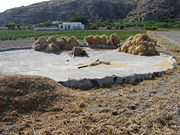
Threshing floor
Encyclopedia

Threshing
Threshing is the process of loosening the edible part of cereal grain from the scaly, inedible chaff that surrounds it. It is the step in grain preparation after harvesting and before winnowing, which separates the loosened chaff from the grain...
the grain
GRAIN
GRAIN is a small international non-profit organisation that works to support small farmers and social movements in their struggles for community-controlled and biodiversity-based food systems. Our support takes the form of independent research and analysis, networking at local, regional and...
harvest
Harvest
Harvest is the process of gathering mature crops from the fields. Reaping is the cutting of grain or pulse for harvest, typically using a scythe, sickle, or reaper...
and then winnow it, before the advent of threshing machine
Threshing machine
The thrashing machine, or, in modern spelling, threshing machine , was a machine first invented by Scottish mechanical engineer Andrew Meikle for use in agriculture. It was invented for the separation of grain from stalks and husks. For thousands of years, grain was separated by hand with flails,...
s from the nineteenth century onwards. The threshing floor was either owned by the entire village or by a single family. It was usually located outside the village in a place exposed to the wind.
Structure
Threshing floors are usually located near a farm or farmhouse, or in places easily accessible from growing areas. They are usually paved with material that may be of various kinds, for example round stone cobblesCobblestone
Cobblestones are stones that were frequently used in the pavement of early streets. "Cobblestone" is derived from the very old English word "cob", which had a wide range of meanings, one of which was "rounded lump" with overtones of large size...
about the size of a fist; slate
Slate
Slate is a fine-grained, foliated, homogeneous metamorphic rock derived from an original shale-type sedimentary rock composed of clay or volcanic ash through low-grade regional metamorphism. The result is a foliated rock in which the foliation may not correspond to the original sedimentary layering...
; tile
Tile
A tile is a manufactured piece of hard-wearing material such as ceramic, stone, metal, or even glass. Tiles are generally used for covering roofs, floors, walls, showers, or other objects such as tabletops...
; or sometimes the underlying bedrock itself is exposed. Unpaved earthen threshing floors are also sometimes found. The floors usually have a slight slope, to avoid water standing on them after rain; and the paving may be divided by rays traced from a central focus to facilitate the pavement.
To overcome possible unevenness, and isolate them from water running off after rain so helping to preserve them, threshing floors are often surrounded by a stout low wall. The construction was often in a high place, to take advantage of soft and steady winds to facilitate the work of winnowing, separating the grain from the chaff, once the threshing had been completed.
Use
Sheaves of grain would be opened up and the stalks spread across the threshing floor. Pairs of donkeyDonkey
The donkey or ass, Equus africanus asinus, is a domesticated member of the Equidae or horse family. The wild ancestor of the donkey is the African Wild Ass, E...
s or oxen (or sometimes cattle
Cattle
Cattle are the most common type of large domesticated ungulates. They are a prominent modern member of the subfamily Bovinae, are the most widespread species of the genus Bos, and are most commonly classified collectively as Bos primigenius...
, or horses) would then be walked round and round, often dragging a heavy threshing board behind them, to tear the ears of grain from the stalks, and loosen the grain itself from the husk
Husk
Husk in botany is the outer shell or coating of a seed. It often refers to the leafy outer covering of an ear of maize as it grows on the plant. Literally, a husk or hull includes the protective outer covering of a seed, fruit or vegetable...
s.
After this threshing process, the broken stalks and grain were collected and then thrown up into the air with a wooden fork-like tool called a winnowing fan. The chaff
Chaff
Chaff is the dry, scaly protective casings of the seeds of cereal grain, or similar fine, dry, scaly plant material such as scaly parts of flowers, or finely chopped straw...
would be blown away by the wind; the short torn straw
Straw
Straw is an agricultural by-product, the dry stalks of cereal plants, after the grain and chaff have been removed. Straw makes up about half of the yield of cereal crops such as barley, oats, rice, rye and wheat. It has many uses, including fuel, livestock bedding and fodder, thatching and...
would fall some distance away; while the heavier grain would fall at the winnower's feet. The grain could then be further cleansed by sieving.

